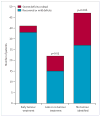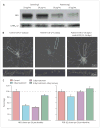Anti-NMDA-receptor encephalitis: case series and analysis of the effects of antibodies
- PMID: 18851928
- PMCID: PMC2607118
- DOI: 10.1016/S1474-4422(08)70224-2
Anti-NMDA-receptor encephalitis: case series and analysis of the effects of antibodies
Abstract
Background: A severe form of encephalitis associated with antibodies against NR1-NR2 heteromers of the NMDA receptor was recently identified. We aimed to analyse the clinical and immunological features of patients with the disorder and examine the effects of antibodies against NMDA receptors in neuronal cultures.
Methods: We describe the clinical characteristics of 100 patients with encephalitis and NR1-NR2 antibodies. HEK293 cells ectopically expressing single or assembled NR1-NR2 subunits were used to determine the epitope targeted by the antibodies. Antibody titres were measured with ELISA. The effect of antibodies on neuronal cultures was determined by quantitative analysis of NMDA-receptor clusters.
Findings: Median age of patients was 23 years (range 5-76 years); 91 were women. All patients presented with psychiatric symptoms or memory problems; 76 had seizures, 88 unresponsiveness (decreased consciousness), 86 dyskinesias, 69 autonomic instability, and 66 hypoventilation. 58 (59%) of 98 patients for whom results of oncological assessments were available had tumours, most commonly ovarian teratoma. Patients who received early tumour treatment (usually with immunotherapy) had better outcome (p=0.004) and fewer neurological relapses (p=0.009) than the rest of the patients. 75 patients recovered or had mild deficits and 25 had severe deficits or died. Improvement was associated with a decrease of serum antibody titres. The main epitope targeted by the antibodies is in the extracellular N-terminal domain of the NR1 subunit. Patients' antibodies decreased the numbers of cell-surface NMDA receptors and NMDA-receptor clusters in postsynaptic dendrites, an effect that could be reversed by antibody removal.
Interpretation: A well-defined set of clinical characteristics are associated with anti-NMDA-receptor encephalitis. The pathogenesis of the disorder seems to be mediated by antibodies.
Figures





Comment in
-
Anti-NMDA-receptor encephalitis: a cause of psychiatric, seizure, and movement disorders in young adults.Lancet Neurol. 2008 Dec;7(12):1074-5. doi: 10.1016/S1474-4422(08)70225-4. Epub 2008 Oct 11. Lancet Neurol. 2008. PMID: 18851929 No abstract available.
References
-
- Lynch DR, Anegawa NJ, Verdoorn T, Pritchett DB. N-methyl-D-aspartate receptors: different subunit requirements for binding of glutamate antagonists, glycine antagonists, and channel-blocking agents. Mol Pharmacol. 1994;45:540–45. - PubMed
-
- Waxman EA, Lynch DR. N-methyl-D-aspartate receptor subtypes: multiple roles in excitotoxicity and neurological disease. Neuroscientist. 2005;11:37–49. - PubMed
-
- Lau CG, Zukin RS. NMDA receptor trafficking in synaptic plasticity and neuropsychiatric disorders. Nat Rev Neurosci. 2007;8:413–26. - PubMed
Publication types
MeSH terms
Substances
Grants and funding
LinkOut - more resources
Full Text Sources
Other Literature Sources
Medical

